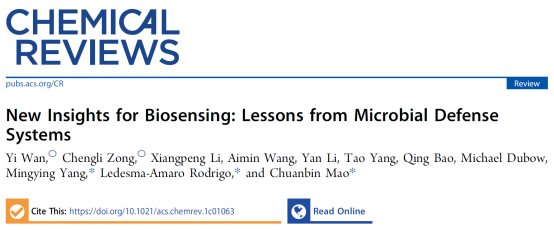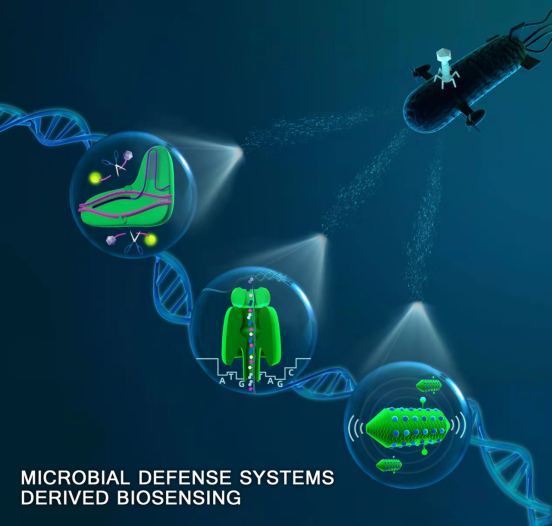
2022年3月2日,海南大学以第一单位在国际权威综述期刊《Chemical Reviews》上发表了题为“New Insights for Biosensing: Lessons from Microbial Defense Systems”的长篇综述评论文章。其中南海海洋资源利用国家重点实验室万逸研究员和药学院宗成利教授共同第一作者,浙江大学杨明英教授、英国帝国理工大学Ledesma-Amaro Rodrigo教授、毛传斌教授为通讯作者(美国科学促进会会士、ACS会士、美国微生物科学院会士、美国医学和生物工程院会士、英国皇家化学会会士)。《Chemical Reviews》是国际科学研究领域影响力最高的学术期刊之一,2021年公布影响因子为60.6。
我们需要向渺小的微生物学习吗?微生物在数百万年的漫长进化过程中获得了免受入侵物种攻击和适应环境变化的防御系统。科学家基于微生物防御系统(MDS, microorganism defense systems),在基因编辑、生物功能机制研究、疾病治疗领域开展了大量研究,在过去10年里,这些基于MDS系统的生物传感器在生物诊断领域得到了蓬勃发展。因此,揭示MDS的机制和开发新一代生物分析诊断技术势在必行。
经过数百万年的自然进化,微生物已经发展卓越的防御系统,从CRISPR-Cas系统、成孔毒素蛋白到浮力控制气体泡。将MDS与光学、声学、磁学、电学和电化学传感器相结合,促进新一代生物传感器的发展。这些生物传感在成本、时间、可扩展性、特异性和灵敏度方面优于基于纳米材料的生物传感平台。它对推进即时检测、环境保护和安全具有很大的应用前景。作者认为,理想的生物传感平台应包括以下特点:(1)试剂和仪器成本低;(2)样本进-结果出的时间短,无需预扩增和信号放大;(3)高灵敏度/准确度/精密度,可实现早期诊断。然而,在资源受限的环境中这三个特征似乎不可能同时满足,影响实际现场应用。必须集合多方努力来应对这些挑战。

Novel biosensing platforms from MDS MDS新型生物传感平台(https://pubs.acs.org/doi/10.1021/acs.chemrev.1c01063)
随着计算机辅助设计、定向进化和蛋白质工程等新计算和生物工具的出现,(1)发现MDS中的新机制,例如参与细菌防御系统的新酶;(2)改造现有微生物防御系统,有利于新型,功能更强大的生物传感的开发。显著提高检测的灵敏度和特异性,用于特异性单碱基分辨或可视化核酸检测。
该综述由国际多部门学者联合完成,感谢浙江大学、帝国理工大学、俄克拉荷马大学、加利福尼亚大学及巴黎萨克雷大学团队的合作支持。感谢国家重点研发计划蓝色粮仓专项、国家自然科学基金及海南大学科研基金的支持。
从2017年入职海南大学以来,万逸研究员专注海洋微生物传感领域,特别是以MDS系统作为生物传感器平台开展了系统工作,以第一作者或通讯作者在《Chemical Reviews》(IF=60.6, 1篇)、《Angew Chem Int Ed》(IF=15.3, 1篇)、《Biosensors&Bioelectronics》(IF=10.6, 4篇)、《Analytical Chemistry》(IF=6.9, 2篇),以第一作者在科学出版社出版专著1部《生物传感器技术检测和诊断病原微生物》(ISBN:9787030548313),实现微生物光电诊断仪成果转化1项,打造以沉淀实践、进化能力和挑战梦想为导向的学生社团组织。
宗成利教授予2020年10月加入海南大学药学院。2021年入选海南省人才计划。 “糖类小分子药物以及多糖疫苗研究创新团队”负责人。团队主要从事糖药物的化学/酶的合成,分析,活性研究等。以第一作者或通讯作者发表多篇文章,包括:《Chemical Reviews》(IF=60.6, 1篇)、《Journal of America Chemical Society》(IF=15.4, 2篇)、《Carbohydrate Polymers》(IF=9.38, 1篇)等。
参考资料:
https://pubs.acs.org/doi/10.1021/acs.chemrev.1c01063
https://hb.hainanu.edu.cn/nanhaihaiyang/info/1051/1105.htm
https://hd.hainanu.edu.cn/yaoxue/info/1029/2236.htm
On March 2, 2022, Hainan University, as the signature unit of the first author, published a review entitled New Insights for Biosensing: Lessons from Microbial Defense Systems in Chemical Reviews, a leading international review journal. Research Professor Wan Yi and Professor Zong Chengli were co-first authors, Professor Yang Mingying of Zhejiang University, Professor Ledesma-Amaro Rodrigo of Imperial College London, and Professor Mao Chuanbin of Zhejiang University (a fellow of multiple professional societies, including American Association for the Advancement of Science (AAAS), American Chemical Society (ACS), American Academy of Microbiology (AAM), American Institute for Medical and Biological Engineering (AIMBE), and Royal Society of Chemistry (RSC)) were corresponding authors. The Chemical Reviews is one of the most influential academic journals in international scientific research, and its impact factor was 60.6 in 2021.
Do we need to learn from the tiny microorganisms? Over millions of years of evolution, microorganisms have acquired defense systems to protect themselves from invasive species and to adapt to environmental changes. Scientists have conducted extensive research in the fields of gene editing, biofunctional mechanisms and disease treatment based on microorganism defense systems (MDS). And in the last decade these MDS-based biosensors have flourished in the field of bio-diagnostics. Therefore, it is imperative to reveal the mechanisms of MDS and to develop a new bioanalytical diagnostic technology.
After millions of years of natural evolution, microorganisms have developed fascinating defense systems ranging from CRISPR–Cas systems, to nanopore-forming proteins, and gas vesicles. This Review has summarized recent advances, challenges, and trends in the rapidly developing area of biosensing platforms derived from MDS. It represents the interdisciplinary effort to emulate biochemical mechanisms of MDS. It shows that integrating MDS with the optical, acoustic, magnetic, electrical, and electrochemical transducers results in the development of biosensors of a new generation. Such next-generation biosensing outperforms nanomaterials-based biosensing in terms of cost, time, scalability, specificity, and sensitivity. It holds great promise for advancing clinical diagnostics, points of care, environmental protection, and food safety. An ideal biosensing platform should include the following features: (1) low cost for both reagents and instruments; (2) short sample-to-result time without the need for target number amplification; (3) high sensitivity/accuracy/precision enabling early diagnosis. However, these three traits seem to constitute an impossible trinity that shadows the onsite applications during an outbreak of an infectious disease or in resource-limited settings.
With the advent of new computational and biological tools such as computer-aided design, directed evolution, and protein engineering, new mechanisms in MDS such as new nucleic acids and enzymes involved in bacterial defense systems can be discovered. The current MDS can also be biologically engineered to gain new functions that are favorable for biosensing through modern bioengineering tools. Eventually, these new and improved MDSs can be further exploited to develop more powerful sensors that can detect biological species with significantly improved sensitivity and specificity, such as single-base resolution for specifically detecting or visualizing nucleic acids
This review is the fruit of scholars from home and abroad, so we gratefully acknowledge supports from Zhejiang University, Imperial College London, University of Oklahoma, University of California and Université Paris-Saclay, and we also thank the supports from the National Key Research and Development Program of China, National Natural Science Foundation of China and Research Foundation of Hainan University.
Since joining Hainan University in 2017, Research Professor Wan Yi has focused on the field of marine microbial biosensing, especially on the MDS system. He, as the first or corresponding author, has published one paper in Chemical Reviews (IF=60.6), four papers in Angew Chem Int Ed (IF=15.3), four papers in Biosensors & Bioelectronics (IF=10.6) and two papers in Analytical Chemistry (IF=6.9), and he has also published one monograph called Detection and Diagnosis of Pathogenic Microorganisms through Biosensing Technology (ISBN: 9787030548313) through Science Press as the first author and had one technology transformation achievement of microbial photoelectric diagnostic instrument. Besides, he has established a student association organization to help students gain more practical experience and abilities and surmount challenges.
Professor Zong Chengli accepted a faculty position in Hainan University in October 2020 and was selected as a member of the“Thousand Talents Recruitment Program in Hainan Province in 2021. As the head of the “Small Molecule Glycoside Drug and Polysaccharide Vaccine Research Innovation Team”, he is mainly engaged in the chemical/enzymatic synthesis, analysis and activity research of glycoside drugs. He, as the first or corresponding author, has published many articles, including one paper in Chemical Reviews (IF=60.6), two papers in Journal of America Chemical Society (IF=15.4), one paper in Carbohydrate Polymers (IF=9.38), etc.
References:
https://pubs.acs.org/doi/10.1021/acs.chemrev.1c01063
https://hb.hainanu.edu.cn/nanhaihaiyang/info/1051/1105.htm
https://hd.hainanu.edu.cn/yaoxue/info/1029/2236.htm
 公众号
公众号